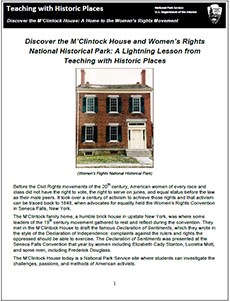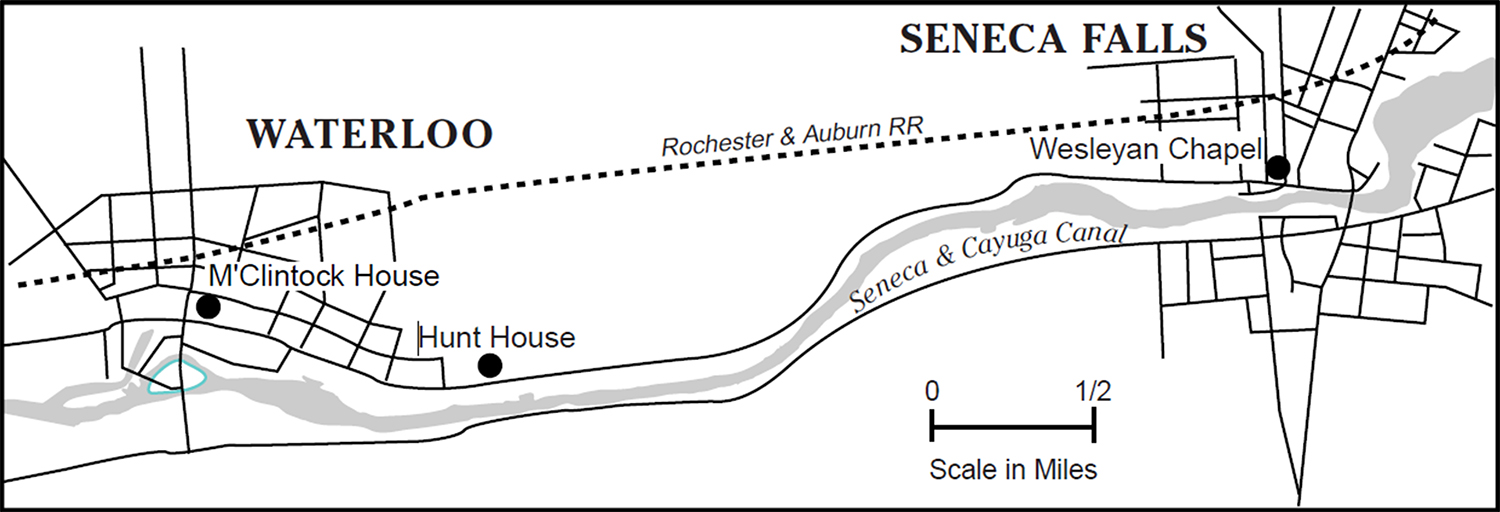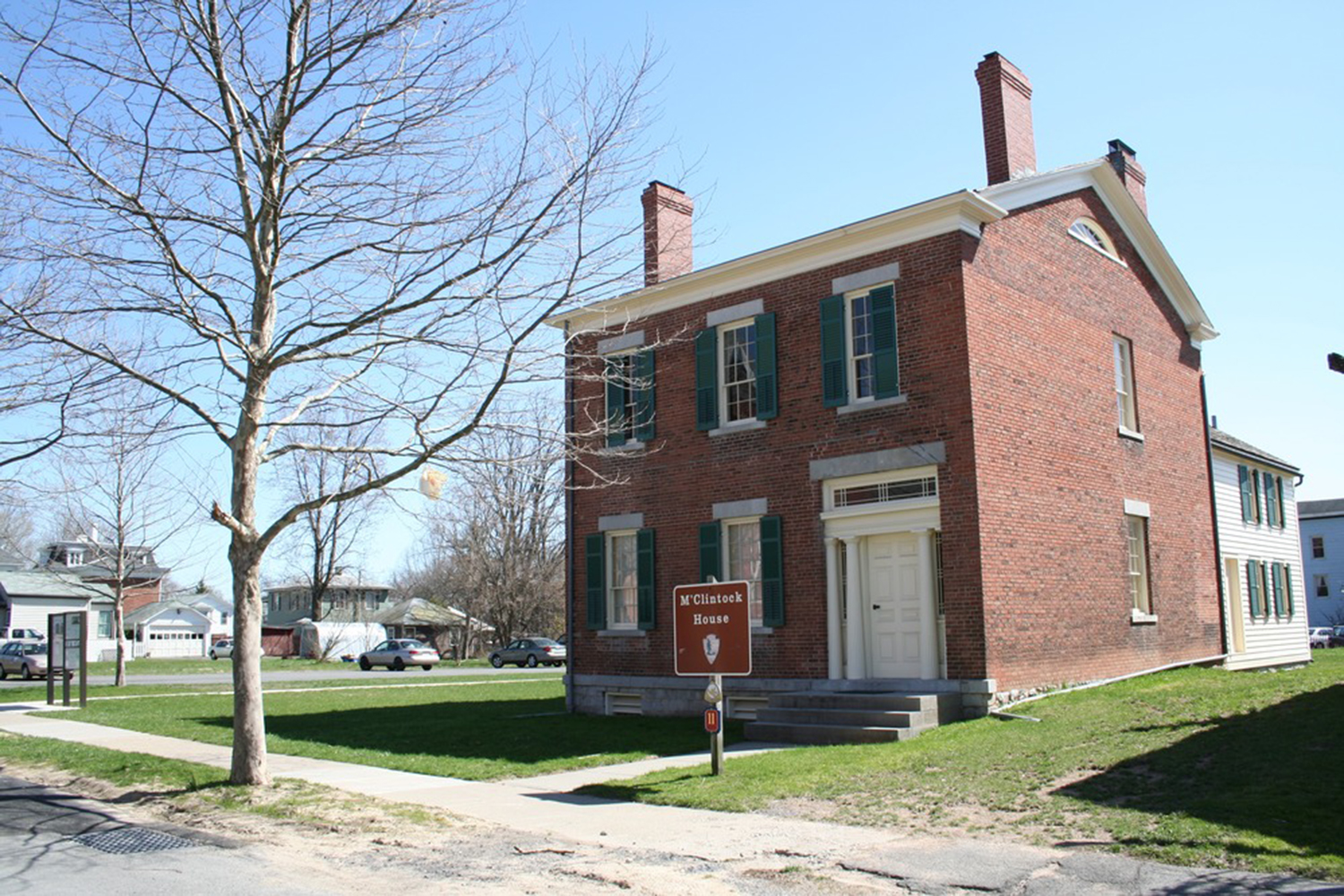
(Photo of the M'Clintock House courtesy Women's Rights National Historical Park)
Contents
| Introduction
| Where it Fits Into the Curriculum (Objectives and Standards)
| Materials in the Lesson (Readings, Maps, Visual Evidence)
| Post-Lesson Activities
| More Resources
| About
Why did American women organize to fight for civil rights in the 19th century?
What historic place might you study to answer this question?
Before the Civil Rights movements of the 20th century, American women of every race and class did not have the Constitutional right to vote, the right to serve on juries, and equal status before the law as their male peers. It took over a century of activism to achieve those rights and that activism can be traced back to 1848, when advocates for equality held the Women’s Rights Convention in Seneca Falls, New York.
The M’Clintock family home, a humble brick house in upstate New York, was where some leaders of the 19th century movement gathered to rest and reflect during the convention. They met in the M’Clintock House to draft the famous Declaration of Sentiments, which they wrote in the style of the Declaration of Independence: complaints against the rulers and rights the oppressed should be able to exercise. The Declaration of Sentiments was presented at the Seneca Falls Convention that year by women including Elizabeth Cady Stanton, Lucretia Mott, and some men, including Frederick Douglass.
The M’Clintock House today is the site of Women’s Rights National Historical Park, operated by the National Park Service, where students can investigate the challenges, passions, and methods of American activists.
Where it Fits into the Curriculum
This lesson could be used in teaching units on 19th century social reform, civil rights, political movements, or women's history.
Time Period: Mid-Nineteenth Century, 1840s.
Objectives
2. To summarize the demands of the women’s rights movement at Seneca Falls, New York, including suffrage;
3. To explain the roles of the M’Clintock family and their house in the women’s rights movement;
4. To investigate and report on other Civil Rights or Reform movements that local residents from the students’ own region or state fought for in the past.
National Standards for History, Social Studies, and Common Core
This lesson relates to the UCLA National Center for History in the Schools National History Standards:
• US History Era 4, Standard 4B: The student understands how Americans strived to reform society and create a distinct culture.
• US History Era 4, Standard 4C: The student understands changing roles based on sex and the ideas and activities of women reformers.
This lesson relates to Thematic Strands from the National Council for the Social Studies' National Standards:
• Theme II: Time, Continuity, and Change
• Theme III: People, Places, and Environments
• Theme IV: Individual Development and Identity
• Theme V: Individuals, Groups, and Institutions
• Theme VI: Power, Authority, and Governance
• Theme VII: Civic Ideal and Practice
• CCSS.ELA-LITERACY.RH.6-8.2
Craft and Structure
• CCSS.ELA-LITERACY.RH.6-8.6
Integration of Knowledge and Ideas
• CCSS.ELA-LITERACY.RH.6-8.7
• CCSS.ELA-LITERACY.RH.6-8.9
Range of Reading and Level of Text Complexity
• CCSS.ELA-LITERACY.RH.6-8.10
See the Full Lesson (PDF) for details about how the these Standards and Themes relate to the lesson.
Materials Found in the Full Lesson
Accompanying Question Sets are paired with all materials in the Full Lesson (PDF).
• Map: Orients the students and encourages them to think about how place affects culture and societyMap 1: Map of Waterloo and Seneca Falls, New York, 1850s.
• Text: Primary and secondary source readings provide content and spark critical analysis.
Reading 1: Declaration of Sentiments, 1848.
Reading 2: Elizabeth Cady Stanton, the M’Clintocks, and the Women’s Rights Convention.
• Visual Evidence: Students critique and analyze visual evidence to tackle questions and support their own theories about the subject.
Photo 1: M’Clintock House in Waterloo, 2007.
- Activity 1: Social Reform
- Activity 2: Women’s Rights in Your Area
- Activity 3: The Right to Vote
Woman’s Rights National Historical Park
The M'Clintock House is one part of this unit of the National Park Service. The park's web pages offer an in-depth look at what occurred in Waterloo and Seneca Falls including: a summary of the First Women's Rights Convention; a listing of those who attended the convention and biographies of the important leaders, such as Elizabeth Cady Stanton and Lucretia Mott; a time line of the major reform movements of the 19th century.
Belmont-Paul Women’s Equality
The Belmont-Paul Women’s Equality National Monument is the home of the National Woman’s Party. Its website contains information on the Equal Rights Movement and on the Suffrage Movement.
Eleanor Roosevelt National Historic Site
Eleanor Roosevelt was a champion of Universal Human Rights. This site is dedicated to her and contains information about her life including during World War II.
Mary McLeod Bethune Council House
Mary McLeod Bethune fought for racial and sex equality. The national historic site and its website includes information about her personal life along with information on civil rights and women’s rights.
National Register of Historic Places: M’Clintock House
The National Park Service's National Register of Historic Places with state and local partners created a travel itinerary called "Places Where Women Made History." The itinerary features a description and photographs of M'Clintock House.
Library of Congress
The Library of Congress Digital Collections offer a wide variety of resources related to the suffrage movement.
-
"The Votes for Women" Suffrage Pictures, 1850-1920 includes portraits, photographs, and cartoons, and a time line of the women's suffrage movement.
-
The National American Women Suffrage Association Collection, 1848-1921 consists of 167 books, pamphlets, and artifacts that chronicle the struggle for women's rights. To view these documents, utilize their search engine
National Portrait Gallery
The National Portrait Gallery summarizes the Seneca Falls Convention and presents portraits of Elizabeth Cady Stanton, Lucretia Mott, and Frederick Douglass.
The University of Rochester
The University of Rochester's History of the Suffrage Movement includes biographies of influential suffragists and a timeline of the movement.
Rutgers University
Rutgers University provides the full Declaration of Sentiments document including notes on the information within the declaration.
This lesson plan is based on the National Register of Historic Places registration file "Women's Rights Historic Sites Thematic Resources." It was published in 2018. National Park Service historian Katie Orr developed this lightning lesson with assistance from education consultant Sarah Curtis. It was produced by NPS Cultural Resources staff in Washington, D.C.
Discover the M’Clintock House and Women’s Rights National Historical Park: A Lightning Lesson from Teaching with Historic Places is based on the earlier Teaching with Historic Places publication, The M’Clintock House: A Home to the Women’s Rights Movement, by education consultant Kathleen Hunter with assistance from consultant Marilyn Harper. published in 2001. Redeveloped and keeping the place-as-evidence model, it is designed to fit within a 60-minute block and is aligned with Common Core standards. This lesson is one in a series that brings the power of place and historic sites to students around the world.
Last updated: February 14, 2025


